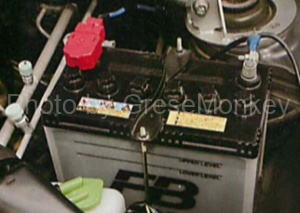In order to get a technical fee for battery replacement
I feel that it is necessary for inspection and maintenance such as tire cracking, shortage of grooves and replacement timing of the battery, etc. to many of the cars that go in inspection and inspection by vehicle inspection. However, I always feel a sense of tooth that can not be explained well in order to get the user to convince that technical thing.

Results of checking the battery and charging / startability
| Battery specific gravity (25 ℃) | 1.22 |
| Battery voltage at engine stop (25 ° C) | 12.9V |
| Discharge current at engine stop | +2.3Within error |
| Lowest voltage at cranking | 8.7V |
| Voltage at no load idle | 14.2V |
| Voltage at full load at 2500 rpm | 14.1V |
| Line voltage drop between the + terminal of the battery and the alternator B terminal at full load at 2500 rpm | 0.2V |
I checked the battery and charge / startability of the car that we got in the car inspection this time, and found that it is necessary to replace the battery. (The above figure) The battery of this car has been used at the time of a new car and has been used for five years.
The problem with this inspection result is the specific gravity of the battery liquid (standard time 1.28) and the battery voltage at the time of cranking, the liquid volume is also small, I think that it is time to replace. Just simply saying that the specific gravity is low and the amount of liquid is small is not an indication of battery replacement. Based on the results at the time of checking the battery performance itself, after judging whether the battery is weak, I think that it is necessary to explain the reason why the replacement time is coming to the user.
Check the battery performance using an oscilloscope

Charge ripple waveform. Left: No load idle Right: Full load 2500 rpm
Using the oscilloscope, the state of charging ripple (current during charging) at battery charging was measured, but no problem was seen. (Above chart)
Also, we measured the cranking minimum voltage and the cranking discharge current before and after replacing the battery. (Lower figure)

Waveform before battery replacement Left: Battery voltage monitor at cranking Right: Discharge voltage monitor at cranking

Waveform after battery replacement Left: Battery voltage monitor at cranking Right: Discharge voltage monitor at cranking
Before replacing the battery, it was the lowest cranking voltage of 8.7 V with the digital meter reading, but it actually decreased to 6 V. And the recovery time to 12 V took 1.1 seconds. The discharge current of cranking is taken out at 250 A in cranking of 1.3 seconds. This is also bigger than the reading of the digital meter.
After replacing the battery, the cranking time is 0.9 seconds and the minimum voltage is about 9V. The cranking discharge current is taken out at 300 A in 0.9 seconds.
It was demonstrated that cranking performance (starting performance) is improved by replacing the battery. A large current can be taken out in a short time, the drop voltage at that time is reduced, and the burden on the battery is small. To summarize this fact briefly, users can explain the necessity of battery replacement and also receive exchange fees.
We receive rewards commensurate with work and technology as a fee
I think that products and technologies with confidence should not be made free. It is because technology can progress and effort can be made only by getting rewards commensurate with work as workers and technologies. I think there are still products and technologies that users will agree with and pay the fee. It seems that not only new things but also a lot of worn out technologies are buried a lot.
